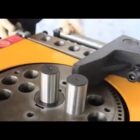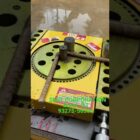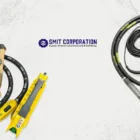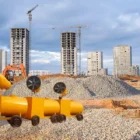Compacting the surface is a prerequisite when building new structures as it provides stability to the building, making it less susceptible to adverse weather conditions. The better the compaction, Wacker Plate the more durable & robust the roads are and the easier it is to build buildings thereupon.
Plate Compactor is a heavy piece of equipment, used for compacting various materials on the ground to create a solid surface and a level grade. So when you are paving a driveway or laying a foundation for a building, a plate compactor readies the soil beneath.
Designed as a powerful & productive machine, a plate compactor should be operated with respect and caution. Hence understanding the operational characteristics and performance of the plate compactor is a must for its operator.
So in this blog, we’re going to guide you through the functioning process of a Wacker Plate (i.e. Plate compactors or Vibratory Plates, designed by the world’s leading construction equipment manufacturer called Wacker Neuson Equipments. Accordingly, you can be better prepared in your next construction set up.
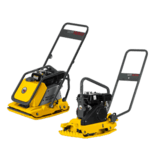
Know what is a ‘Wacker Plate’ and what is it used for?
A Wacker plate, also known as a ‘Plate Compactor’ or ‘Vibratory Plates’, is useful construction equipment with a vibrating metal base plate and an engine or motor on top of it. Wacker Plate is used for making the ground surface smooth; such as leveling the soil, finishing the asphalt paving. It operates by transmitting vibration through a vibrating plate, which is power generated from the single motor in a vibrator case. It is ideal for creating a solid compact base for a number of DIY projects like a shed or greenhouse base, a new pathway, or a garden pond.
What type of a Wacker Plate is it?
Plate compactors come in various sizes and designs. They can range from a manually pushed machine, used by one person to a massive industrial machine that is either automated or driven. While the plate compactors can have a wide variety of accessories and details, the basics of the machine remain the same.
- Single Direction Vibratory Plates: Single-direction Vibratory Plates are easy to operate and are mainly used for smaller surfaces and in landscaping. They are ideal for surface-level compaction and simple, small jobs. Single direction Vibratory Plates move in forwarding motion only.
- Reversible Vibratory Plates: Reversible Vibratory Plates are suitable for larger construction applications. Unlike Single Direction Vibratory Plate, Reversible Vibratory Plates can operate by going both forward as well as in reverse. Plus they are capable of penetrating much deeper into the soil. Their versatility makes them more expensive as compared to the single-direction vibratory plates.
How to use a Wacker Plate ?
Electric Plate Compactor: As the name suggests, an Electric Plate Compactor runs through electricity. Its operator needs a transformer, generator, or 110v site power supply, along with a 110v extension lead, to run this equipment.
To start a 110v electric plate compactor, plug the transformer into a normal 240v electric supply and then connect the transformer to the wacker plate using a 110v extension lead. Press the green button on the control handle to turn the equipment on and it will start to vibrate. Move it forward to compact the ground. And simply press the red button to stop the machine.
Petrol Vibrating Plate: A petrol Wacker plate is a more professional and efficient machine than the Electric Wacker Plate.
There are a few steps to follow in order to start it right:
- Open the choke. Move the choke lever at the back of the plate compactor to the right to open the Fuel tap, if you’re starting the engine from cold. But if you are restarting a warm engine you may not need to use the choke, or you may only need to partially open the choke.
- Turn the ‘ON/OFF switch on the side of the machine to the ‘ON’ position.
- Make sure you set the throttle at the side of the machine to the idle position. It means that when you pull to start the engine, the compactor won’t start immediately at the full vibration and move forward.
- Hold the control handle with one hand and hold the pull cord starter with your other hand. Then pull the starter cord until engine resistance is felt. Let the pull cord return to its starting position. Repeat this step until the engine starts. (The engine should start after 2 or 3 pulls. However, if the Wacker plate doesn’t start after 6 or 7 attempts, crosscheck if you have followed the start-up procedure correctly. If you still can’t rectify the issue, contact our expert ).
- Once the engine has started, close the choke using the choke lever (or only partially close it, if required).
- Set the throttle lever to fully open. The Wacker plate will then increase its vibrations and begin to move forward. It is then ready to use.
- Once the throttle is fully open, the Wacker plate will start moving forward due to its own vibration. Use the control handle to direct and maneuver the Wacker plate in a straight strip over the surface area. Once you have completed a strip along the area you intend to compact, just turn the equipment around and move it along in another strip next to the area you’ve covered. You may need to go over the area a number of times, at perpendicular passes to the previous pass, in order to compact the area accurately.
- Once you have finished compacting work, you can switch the machine off. Simply press the Off button to turn off an electric vibrating plate. To turn off a petrol plate compactor-
- Set the throttle back to idle. It will reduce the vibrations and stop the machine from moving.
- Leave the motor running on idle for a couple of minutes to let the machine settle.
- Turn the ‘ON/OFF switch to the ‘OFF’ position.
- Close the choke completely, if it has been left partially open.
Which Factors should be kept in mind while using a Wacker Plate?
- Use petrol & diesel wacker plates in outdoors, well-ventilated areas only. Refrain from using them indoors or in confined spaces. For indoor applications, use an electric wacker plate.
- Store the wacker plate in a dry and secure location such as a shed or garage; as it needs to be kept dry.
- If you run the machine for consecutive days, make sure you keep it clean.
- You must wear the required safety equipment while operating a Wacker Plate.
- Check the fuel and oil levels regularly and refill the tank when required.
- Never push the machine beyond its design operational limits.
- Never refuel the Wacker plate when its engine is either hot or running. Turn the machine off and allow the engine to cool down before refilling.
- Make sure that the area to be compacted does not contain any “live” electrical cables, gas, water, or communication services that may be damaged by the action of the vibration.
- You may need to use a Wacker plate multiple times over an area before beginning construction, depending on the ground conditions. You can make extra passes at perpendicular angles to the previous pass in order to compact the area most effectively. You may need to put down more hardcore between each application and then compact that fresh hardcore down.
Plate compactors are expensive tools to buy. So if you need a Wacker plate only for a DIY job or just for a few professional jobs, it makes more sense to hire a Wacker plate than to invest in one. We have Wacker plate hire available. Contact Smit Corporation to hire a Wacker plate from our Plate compactors collection at the most competitive price in the industry.



